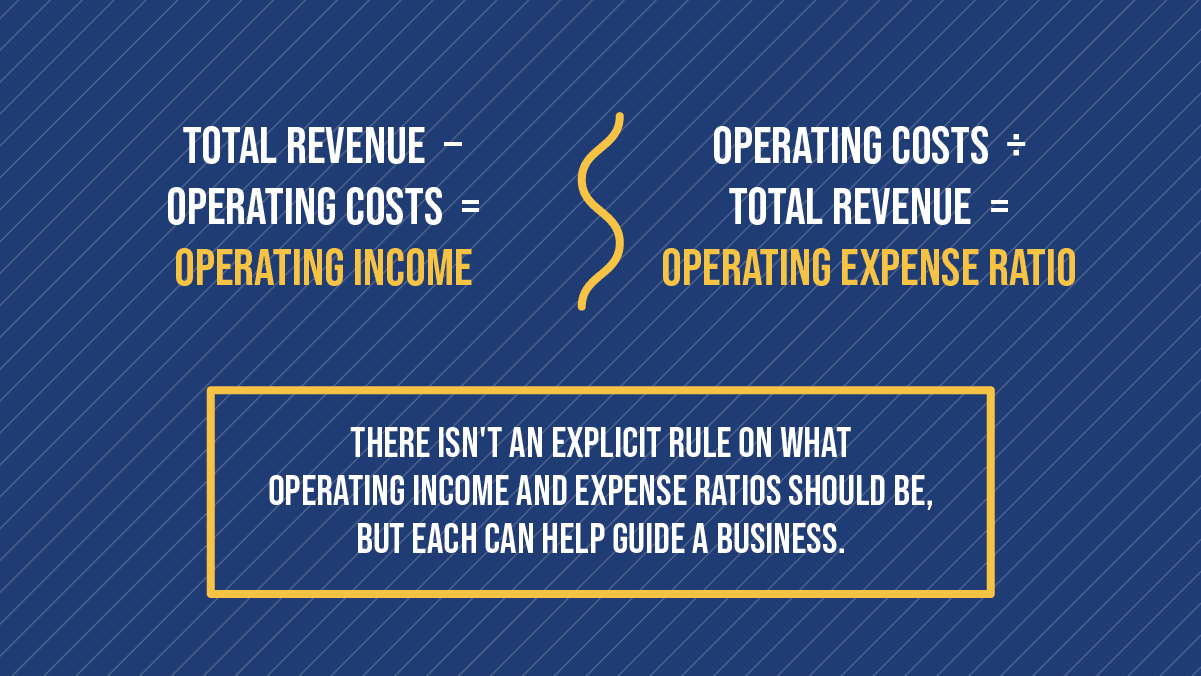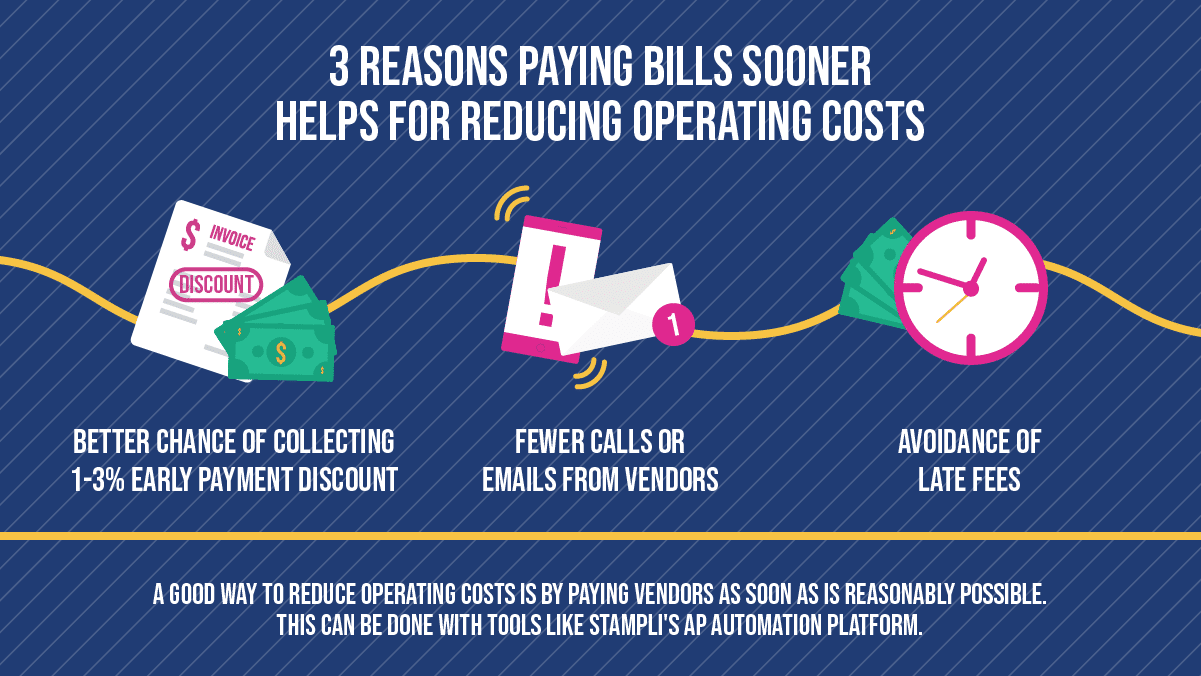Reducing Operating Costs: How AP Automation Helps Get the Job Done

Times are challenging for businesses these days, with rising interest rates, inflation, and uncertainty in the air.
The good news: Businesses don’t have to just accept their lot and wait for the worst. Options remain, with companies having all sorts of methods at their disposal to reduce operating costs and increase profits.
Today, we’re going to look at a range of strategies for reducing operating costs, many of them geared around one of the secret weapons of the business world: Utilizing accounts payable automation software and related tools.
Basics of Reducing Operating Costs
If you operate a business, you probably have operating costs. As Investopedia notes, “Operating costs are associated with the maintenance and administration of a business on a day-to-day basis.” Operating costs include cost of goods sold (direct costs incurred to make a product or deliver a service) and operating expenses.
Operating income is fairly simple to calculate, only requiring that a company subtract its operating costs from total revenue. Operating costs can also be divided by revenue to provide a company’s operating expense ratio. This ratio is typically used to assess the profitability of real estate investments, but the ratio can also be applied to other businesses.

There isn’t a hard and fast rule on what a business’s operating costs, income, or expense ratios should be. These can vary wildly between different company sizes and industries. A freelancer might need little more than a laptop to operate their business. A high-volume manufacturing concern, on the other hand, might spend a considerable amount on operating expenses, or OPEX and get by on tight margins.
What either business type has in common, though, is that each probably has some room to adjust its operating costs. Businesses can also be vulnerable to economic shifts or downturns and want to have every tool at their discretion to safeguard their operations.
Why it’s Vital to Reduce Operating Costs
Although the old saying in business is: “You have to spend money to make money”, this shouldn’t mean spending indiscriminately – or endlessly borrowing to spend money that can’t be repaid with cash inflows.
While America has had very low interest rates in recent years, the Federal Reserve has been talking about raising rates three times in 2022. With potential rate increases and an elevated level of inflation, which reached 7% in 2021, companies might need to be more fiscally cautious.
More than this, a company that reduces its business costs will find itself with lower costs and smaller debt obligations. The firm will have more money for the things that matter most, while maintaining a buffer to get through the inevitable lean times.
Challenges Associated with Reducing Operational Costs
Many businesses would no doubt like to lessen their expenses, increase profit margins, and improve cash flow. So what gets in the way? Various factors.
For one thing, businesses might not realize that it’s possible to reduce OPEX. They might have concluded a long time ago that they’re simply in a high-cost industry and that there’s little they can do except spend. There can also be a lot of pressure for businesses to borrow, with US corporate debt hitting $11 trillion in 2021.
Business owners and their management might be fully cognizant of the advantages of achieving cost savings and carrying lower debt. But with so much focus needed to provide a product or service, some companies might not have time to analyze expenses.
Spend management can also be a tricky game, particularly for companies that lack the tools for it – though as we’ll explore in a bit, some easily-implementable options go a long way toward reducing operating costs.
6 Strategies to Reduce Operating Costs
Many strategies can be found online to reduce operating costs. Here are six cost reduction strategies worth considering:
1. Reduce Employee Churn – and Look Elsewhere to Save Money
Some companies might start reducing business expenses by attempting to trim their workforce, limit compensation, turn full-time employees into part-time ones, or slash perks and employee benefits, such as choosing barebones health insurance plans.
This can be misguided.
For one thing, productive employees, particularly workers with specialized skills, can be hard to come by. Downsizing can also affect morale and lead to more work for human resources and resignations. Losing employees isn’t cheap, with a financial wellness firm making note of research showing that it takes 6-9 months of salary to replace employees.
The truth, too, is that companies can all too frequently look to labor costs first when they’re trying to save money. It’s not necessarily a bad thing to consider outsourcing instead of hiring an employee. But once an employee is hired, many better options can be deployed before a company reduces its workforce or salaries.
Downsizing should be a matter of last resort after other options are exhausted. It’s just too expensive.
2. Focus on Customers, Vendors, and Suppliers That Are a Good Fit
There can be temptation during tough times to chase the business of any customer that comes along. This isn’t always the best thing. More customers can mean more overhead costs for a business, a higher cost of goods sold (COGS) balance, and more customer service costs. This is true regardless of the price point of the product or service.
It’s also not worth it to chase every potential vendor or supplier. Not all of them will be able to offer a price, expertise, or business relationship that makes working together worth it. What’s better is to try to identify your strongest customers, vendors, and supply chain partners and focus as much as possible on them. There are tools we will explain more about in a bit that help this process along.
3. Get Strategic About Your Accounts Payable Processes
Approximately half of all businesses are still doing much of their accounts payable processing by hand, from the point they receive an invoice to when they’re performing month-end reconciliations. Many companies have updated some of their AP processes on an ad hoc basis, most commonly invoice scanning, but there’s still usually a lot that could be upgraded.

One of the best cost reduction strategies for companies that receive a high volume of invoices is to implement AP automation software. SaaS-based AP automation platforms can drastically reduce the time and cost it takes to process invoices and with fewer errors.
AP automation can also cut expenses in other ways, with 44% of companies noting that it led to a reduction in paper volume, according to a 2021 whitepaper by Stampli and Treasury Webinars, “The How, the Why & the ROI of AP Automation.”
Even for companies that might not receive enough invoices to justify automation, such as freelancers, startups, or mom-and-pop businesses, managers can reduce operating expenses by getting strategic about AP. They can batch their invoices to make payments on set days so that less staff time is consumed. Or they can look to pay bills early to collect early payment discounts, often 1-3% of invoice amounts, or inquire about discounts if vendors aren’t offering them.
4. Avoid a One-Size-Fits-All Approach With Payment Methods
Companies might not always think a whole lot about how they’re paying their bills, be it check, credit card, ACH, or another form of payment. In a 2021 whitepaper by Stampli and Treasury Webinars, “How & Why Companies Choose Payment Types,” 37% made their choices based on supplier preference while 31% simply did things the way they’d always done them.
Taking this approach can force companies to pay bills in ways that might not be the most efficient. Paper checks can take longer to process and thus have hidden costs. The ACH, while generally one of the cheapest ways to pay, might lead a company to lose out on an early payment discount, since these sorts of payments sometimes have to be scheduled a few days in advance.
5. Rein in Spending
Frugality gets a bad rap sometimes in this world. Truth is, businesses probably have a lot of inefficiencies and expenditures that they could streamline, trim, or eliminate altogether for the sake of their financial health.
Amid the COVID-19 pandemic and the shift to remote work and telecommuting, many companies have found that they need less office space and office supplies in these workspaces. This can also mean fewer subscriptions and business functions needed at the office, perhaps a lower level of internet connectivity, even things as simple as fewer light bulbs. It’s never a bad idea to consider canceling unused services either.
Businesses can also rein in spending by switching to energy-efficient windows and utilities, which can help reduce variable costs such as heating bills. They can refinance debt while interest rates are still low to reduce interest costs.
6. Analyze Data to Finetune Spending
Companies are getting wise to the wealth of data within their AP departments. In another report from Stampli and Treasury Webinars, “AP in 2022: Expectations, Technology, Opportunity” data management and data analytics were identified as the No. 2 and No. 3 most important skills for AP teams to upgrade in 2022.
The reward for strengthening these skills is being able to analyze purchasing trends by different departments, get an idea of what different vendors are charging (including quantifying who might be well outside the norm), and keep an eye out for possible signs of fraud.
AP workers can do this analysis simply by looking through invoices and their accounting systems. They can also use AP automation software that has AI and machine learning capabilities built in that can automatically analyze purchases.
How Stampli Helps Reduce Operating Costs
For companies that desire lower operating costs, here are a few ways that Stampli helps to get the job done.
Faster Invoice Processing
A 2021 survey report by Stampli and Treasury Webinars, “AP Today: Bottlenecks, Benchmarks & Best Practices” found that small businesses needed an average of 15 days to process and pay invoices while medium-sized businesses needed 17 days. AP departments at enterprise-level firms needed 20 days- and that’s just an average. The report also noted that 5% of companies let payments sit unapproved for over 30 days.

Obviously, the longer an invoice sits, the less chance a company has of collecting an early payment discount. Staff time can also be consumed with anxious calls or emails from vendors and suppliers. There can even be late fees on the invoices.
With Stampli, though, companies can drastically reduce the time and money they spend to process invoices. Instead of weeks or months, invoices can get processed straight through in a matter of days.
Easy Payments
When a company does its invoice processing in one place and has to go elsewhere to actually make a payment, it’s difficult to reduce operating costs. At best, it’s disconnected and inconvenient. At worst, details can get mixed up going from one system to another, with incorrect payment amounts getting applied.
Platforms like Stampli, however, via its Stampli Direct Pay initiative, allow payments to be made within the system via the ACH or its virtual card, the Stampli Card, making it so that companies can do all of their invoice and payment processing in one place. It helps make it so that all necessary data resides in one system and that nothing is lost.
Spend Management Insights
When companies use any of Stampli’s solutions, they don’t just get a more efficient and cost-effective way to pay bills. They also get instantly-available spend management insights that can be accessed in an easy-to-use dashboard.
Times are tough and uncertain right now. While tools like Stampli can’t completely alleviate the challenges businesses face, they can make it a lot easier for them to reduce operating costs.
Get a free demo of Stampli and improve your bottom line today




